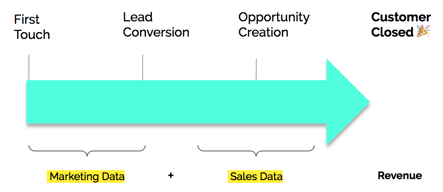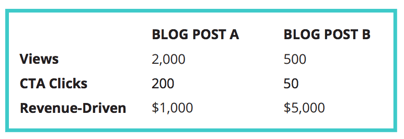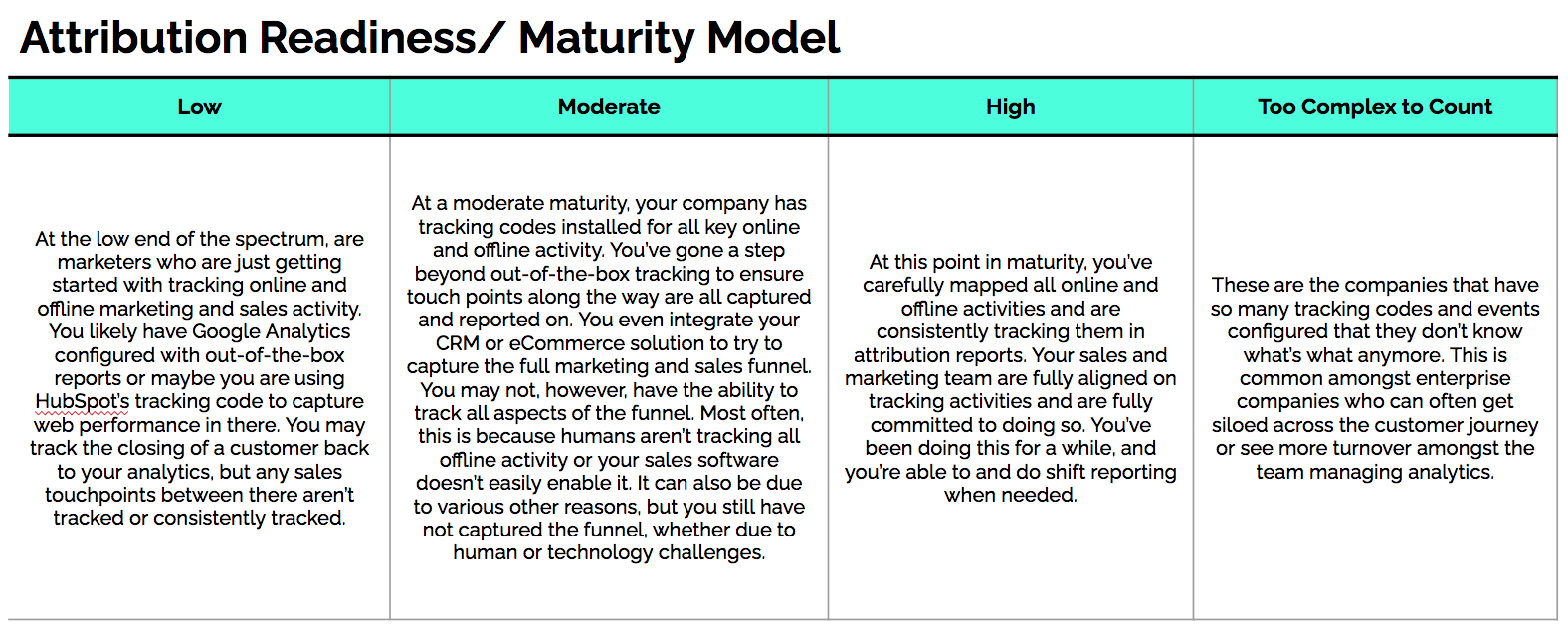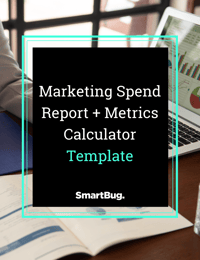
How SaaS Marketers Can Prove ROI with Revenue Attribution
June 23, 2020
By Kristen Deyo
I’ve spent my career in B2B SaaS, both in-house and on the agency side, and there’s one thing I’ve learned: Our job is hard (yes, I said it!). SaaS marketers are increasingly being asked to connect their efforts back to revenue growth. Simple lead generation is not enough. Conversions are not enough. And yet, tying marketing efforts back to revenue is not always easy. In fact, 4o percent of marketing teams find proving ROI of their marketing activities to be their top challenge.
How can SaaS marketers set themselves up for success and tie every effort back to revenue? Here’s how you can start proving ROI using revenue attribution.
What Is Revenue Attribution?
While marketing attribution provides specific analytics of the journey users take to get to your website and navigate through your site before they actually convert, revenue attribution takes this one step further.
Revenue attribution empowers marketers to reliably identify which campaigns are helping drive incoming business revenue. It is worth noting that revenue attribution relies on both marketing and sales data sets to show which channels are resulting in downstream revenue.

Thus, we’re not just focused on visitors becoming leads, but also leads becoming opportunities becoming closed-won revenue. Having both marketing and sales data helps inform which channels are driving the most success. I love this example from Bizible that highlights the powerful difference between understanding the number of conversions versus being able to actually tie marketing efforts back to revenue:

If we looked at the performance of both blog posts without understanding attributed revenue, we would all point to Blog Post A as being the clear-cut winner. The addition of sales data not only has the power to complete the picture, but to change the narrative altogether. Sales data helps SaaS marketers prioritize where and how they should best optimize their efforts for success.
Why Does Revenue Attribution Matter?
The truth is SaaS marketers really can’t afford to skip tying their efforts back to revenue. In fact, HubSpot estimates that inbound marketing budgets are cut at least 12 percent more in companies that don’t focus on and calculate ROI. A few other reasons why revenue attribution matters:
- Over 67 percent of buyers used more than one channel to make a purchase decision (Oracle).
- Attribution models can help provide efficiency gains of between 15 and 30 percent (Net Imperative).
- Only 35 percent of marketers said that understanding the ROI of their campaigns is “Very Important” or “Extremely Important” (HubSpot).
Thus, it’s never been more important to tie your efforts back to revenue.
6 Ways SaaS Marketers Can Prove ROI with Revenue Attribution
OK, we’re finally here. The reason you probably clicked this blog in the first place. Here are six ways you can get started with revenue attribution to prove ROI:
1. Make Sales and Marketing Alignment a Priority
Sales and marketing alignment is a key cornerstone to inbound marketing and revenue attribution success. However, although alignment seems straightforward, in my experience, it can be the hardest thing to achieve.
Your teams need to be on the same page. Why? Because companies with marketing and sales alignment experience higher customer retention, improve close rates, and drive more revenue. In fact, companies with strong marketing and sales alignment achieve a 20 percent growth rate compared to those that don’t.
To determine whether or not you already have sales and marketing alignment, ask yourself these questions:
- Do our sales and marketing teams have a service-level agreement (SLA)? If so, are we reviewing it monthly or quarterly?
- Do we have shared definitions for lifecycle stages?
- Do we have a documented sales process that includes the role of marketing with expectations of how and where sales follow-up will happen?
- Is it clear who owns what tools? Are those systems speaking to one another?
- Are sales and marketing goals aligned?
If you answered “No” or “I don’t know” to any of the above questions, that’s a sign that you probably need better alignment. (Here’s a blog about sales and marketing alignment that’s worth reading!)
2. Break Down Data Silos
According to Net Imperative, 59 percent of marketers say data collection and centralization is their biggest challenge. Furthermore, nearly half of those marketers also have concerns about accuracy when it comes to successfully reporting ROI.
You need marketing and sales data sets in order to tie your efforts back to revenue. Here are some pro tips ensure you prevent any data blindspots:
- Automate data collection where possible including conversions, landing pages, and any other places that could create blind spots.
- Use filters to help see MQLs, SQLs, and other segments of attribution.
- Ensure systems and tools are integrated and transferring any customer journey data possible.
3. Use Closed-Loop Reporting
Having your website, CRM, and marketing automation all within one platform makes things a lot easier, but the reality is most companies don’t and that’s OK. However, ensuring these systems are speaking to one another and seamlessly passing along data is critical to mission success. Both sales and marketing need end-to-end visibility into data from prospect to closed revenue.
Pro tip: Create a martech spreadsheet that showcases all the technologies used across the organization and who owns them. This is a great way to take stock of all the data points that may need to be connected in order to ensure your reporting is accurate.
4. Choose the Right Technology
I still remember trying to use Google Analytics, Salesforce, HubSpot, and our own homegrown CMS to manually map customer journeys in an attempt to do attribution reporting in a Salesforce dashboard. Every month, I felt like Sherlock Holmes: constantly looking for clues, cause and effect, manually looking at opportunities, and trying to see if they had engaged with marketing before another team claimed the lead as their own. It took a lot of time and effort, and I never knew for certain that what I was reporting was accurate.
Attribution technology has come a long way, to say the least. Now, there are powerful tools that make attribution modeling and reporting much easier. Choosing the right technologies to help support by not only automating how and where data is collected, but by also unifying the data in a centralized place is critical.
Our team has been digging into HubSpot’s attribution reporting capabilities, which includes revenue attribution, but there are other leading attribution platforms you can explore.
5. Determine Your Attribution Readiness
Attribution is a journey, not a destination. Some of us are just getting started. Some of us are doing it manually. And some of us are using a form of attribution modeling but still having challenges accurately calculating ROI.
Before you start playing around with attribution models, it’s important to understand where you’re at in your own attribution journey—as a SaaS marketer and as an organization. I recently sat in on an internal training where my fellow SmartBug, Amber Kemmis, shared this awesome “Attribution Maturity/Readiness Model” that she put together to help companies gauge where they are:

Once you plot yourself on this chart, you should have some deeper insight into any gaps so you can set yourself up for revenue attribution success.
6. Play Around with Revenue Attribution Models
OK, we’re ready to start playing with attribution and tying our efforts back to revenue (Yay!).
Your sales and marketing teams are aligned and regularly collaborating. You have completed a martech audit and have a solid understanding of how data is flowing. Even better, you’ve worked with your team to ensure you’re tracking the customer journey across channels. You have the right technology in place to bring all this data together. Finally, you understand your attribution maturity so you’re ready to choose a model that makes the most sense for your organization.
How do you choose the right revenue attribution model for your company? The best choice will depend on your level of attribution maturity and readiness, but also what your revenue attribution priorities are. Here is a breakdown of revenue attribution models and key things you should be thinking about for each:
- First Interaction: 100 percent of the credit is assigned to the first interaction.
Use case: Understanding what pieces of content are influencing the most revenue in your funnel or how much total revenue your blog generated.
- Last Interaction: 100 percent of the credit goes to the last interaction. This will identify the value of actions taken at the bottom of the sales funnel.
Use case: Understanding what is driving the sale/close of a deal.
- Linear: Credit is split equally across all interactions. This can be a useful baseline report to have in your pocket, especially when getting started with attribution reporting, because it helps you see how contacts interact with assets before closing a deal.
Use case: Understanding what parts of your business are most valuable, as measured by the revenue generated by customers.
- U-Shaped: 40 percent of credit is assigned to the first interaction, another 40 percent is assigned to the interaction that led to the lead creation, and the final 20 percent is split equally among all other interactions between first interaction and lead creation. This model emphasizes the top half of the customer funnel, assigning 80 percent of the credit to the interactions where your contact first interacts with your business, and then when it becomes a lead in your CRM. The remaining credit goes to other interactions.
Use case: Understanding what pieces of content on your website are getting leads into your CRM that are going to close and earn revenue for your company.
- W-Shaped: 30 percent goes to the asset that led to the first interaction, 30 percent goes to the asset that led to lead creation, and 30 percent to deal creation, while the remaining 10 percent is split equally among all other interactions between first interaction and deal creation. This model is still mostly focused on marketing efforts, although the inclusion of deal creation can give further insight into the handoff between marketing and sales at this point in the customer journey.
Use case: Understanding what marketing tools are valuable to you in trying to get customers to create a deal on your e-commerce site.
- Full-path: 22.5 percent of credit goes to the first interaction, 22.5 percent to lead creation, 22.5 percent to deal creation, 22.5 percent to last interaction, and the remaining 10 percent is split equally among remaining interactions. This model is able to take into account the important stage between deal creation and deal closing, which would be ideal for representing business models where deal negotiation is more lengthy.
Use case: Understanding what is driving contacts to your site, as well as what is getting visitors to fill out forms and sign deals.
Attribution is not always easy, but I can promise you it is worth it. Nothing is more important (or rewarding) than being able to tie your hard work back to revenue and see how your efforts are driving growth for your organization. Remember, we’re all at various stages of our attribution maturity, and it takes practice and refinement to get it right.
About the author
Kristen Deyo was formerly a Director of Marketing Strategy at SmartBug based in Kingston, Ontario, Canada. She has 8+ years experience developing strategies for primarily B2B SaaS/technology companies and hyper-growth startups. She holds degrees from Queen's University (Cha'Gheill!) and the St. Lawrence School of Business. When not digitally plugged in, you can find her enjoying a good happy hour or planning her next adventure. Read more articles by Kristen Deyo.





















